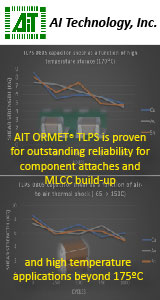|

|
|
| Ask the Experts | |||||||
|
|||||||
|
December 10, 2024 - Updated September 8, 2016 - Originally Posted Frequency of Temperature and Relative Humidity TrackingWe have constant monitoring devices for temperature / relative humidity and are recording in our work/assembly areas. Is there any form of standard on how often we should be recording this data? Or is it just enough to prove that we are in compliance at any given time? B.S. |
|||||||
| Expert Panel Responses | |||||||
|
There is no form on how often this should be done, but I would think the systems can continuously monitor the environmental conditions and those could have limit sensors identifying when the limits are exceeded. This would also provide data of the compliance requirements.
Vice President, Technical Director EPTAC Corporation At EPTAC Corporation, Mr. Lambert oversees content of course offerings, IPC Certification programs and provides customers with expert consultation in electronics manufacturing, including RoHS/WEEE and lead free issues. Leo is also the IPC General Chairman for the Assembly/Joining Process Committee.
If your monitors have the capability of recording the information so that you may produce it at any time then it is perfect. Also an automated system is much easier that having the operator or technician record temperature and humidity settings across a number of sensors/stations.
Senior Manufacturing Engineer Northrop Grumman Edithel is a chemical engineer with 20 year experience in manufacturing & process development for electronic contract manufacturers in US as well as some major OEM's. Involved in SMT, Reflow, Wave and other assembly operations entailing conformal coating and robotics.
There's no standard that I'm aware of. From a practical standpoint, it's very dependent on the physical characteristics of your facility. If, for instance, your facility is subject to rapid changes due to opening/closing of dock doors, then a faster rate of recording may be beneficial to you to understand the impact of the transients. In a situation like that, I have used intervals between 1 minute and 5 minutes between readings. Bottom line, these days data storage and transmission is so cheap that there is little penalty for acquiring more data, however we should be careful to not be taking data that we will never use, or taking so much data that analysis becomes burdensome.
Process Engineer Astronautics Fritz's career in electronics manufacturing has included diverse engineering roles including PWB fabrication, thick film print & fire, SMT and wave/selective solder process engineering, and electronics materials development and marketing. Fritz's educational background is in mechanical engineering with an emphasis on materials science. Design of Experiments (DoE) techniques have been an area of independent study. Fritz has published over a dozen papers at various industry conferences.
|
|||||||
| Submit A Comment | |||||||
|
Comments are reviewed prior to posting. You must include your full name to have your comments posted. We will not post your email address. |
|
Free Newsletter Subscription
Circuitnet is built for professionals who bear the responsibility of looking ahead, imagining the future, and preparing for it. Insert Your Email Address |
|
|





